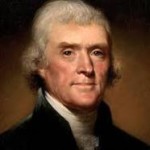 This video is profoundly disturbing on a couple of levels. While an unglued, obviously deranged woman was busy assaulting innocent people, she was also claiming to teach children about a subject she clearly knows very little, if anything about — the U.S. Constitution.
This video is profoundly disturbing on a couple of levels. While an unglued, obviously deranged woman was busy assaulting innocent people, she was also claiming to teach children about a subject she clearly knows very little, if anything about — the U.S. Constitution.
It never ceases to amaze me, how many people can believe they know things with certainty, yet are absolutely, and often provably wrong.
Take, for example, my atheist friends enamored with the phrase “separation of church and state,” often citing it as their favorite part of the Constitution.
The problem is that the phrase “separation of church and state” cannot be found in the U.S. Constitution, or in any of its amendments.
Here’s my most cynical offer — I’ll pay one thousand dollars reward to anyone who can show me where the exact words “separation of church and state” appear in the Constitution.
No, I’m not being generous.
I’m very confident I’ll keep my money because I know where the phrase originated, verbatim; it came from a letter Thomas Jefferson wrote to assure the Danbury Baptists in Connecticut that http://czechinthekitchen.com/2012/04/08/potato-pancakes/?share=jetpack-whatsapp freedom of religion in our new nation would never be limited to one official church.
And don’t try to tell me they are in there somewhere, in spirit. If you’re an atheist, you don’t believe in spirits, do you?
The words specifically in our Constitution guarantee freedom Mandan of, and certainly not from, religion.
“Separation of church and state” only meant there will never be a state-sponsored church, like the Anglican Church was in England.
That meant Catholics, Baptists, Lutherans, Jews, Hindus, Muslims and all others were all free to worship their own versions of God, as long as they did not infringe upon the right of their fellow American citizen to do likewise.
And nothing more.

Separation of church and state is a bedrock principle of our Constitution much like the principles of separation of powers and checks and balances. In the Constitution, the founders did not simply say in so many words that there should be separation of powers and checks and balances; rather, they actually separated the powers of government among three branches and established checks and balances. Similarly, they did not merely say there should be separation of church and state; rather, they actually separated them by (1) establishing a secular government on the power of “We the people” (not a deity), (2) saying nothing to connect that government to god(s) or religion, (3) saying nothing to give that government power over matters of god(s) or religion, and (4), indeed, saying nothing substantive about god(s) or religion at all except in a provision precluding any religious test for public office. Given the norms of the day, the founders’ avoidance of any expression in the Constitution suggesting that the government is somehow based on any religious belief was quite a remarkable and plainly intentional choice. They later buttressed this separation of government and religion with the First Amendment, which constrains the government from undertaking to establish religion or prohibit individuals from freely exercising their religions. The basic principle, thus, rests on much more than just the First Amendment.
That the phrase “separation of church and state” does not appear in the text of the Constitution assumes much importance, it seems, to some who mistakenly supposed it was there and, upon learning of their error, reckon they’ve solved a Constitutional mystery. To those familiar with the Constitution, the absence of the metaphor commonly used to name one of its principles is no more consequential than the absence of other phrases (e.g., Bill of Rights, separation of powers, checks and balances, fair trial, religious liberty) used to describe other undoubted Constitutional principles.
To the extent that some nonetheless would like confirmation–in those very words–of the founders’ intent to separate government and religion, Madison and Jefferson supplied it. Madison, who had a central role in drafting the Constitution and the First Amendment, confirmed that he understood them to “[s]trongly guard[] . . . the separation between Religion and Government.” Madison, Detached Memoranda (~1820). He made plain, too, that they guarded against more than just laws creating state sponsored churches or imposing a state religion. Mindful that even as new principles are proclaimed, old habits die hard and citizens and politicians could tend to entangle government and religion (e.g., “the appointment of chaplains to the two houses of Congress” and “for the army and navy” and “[r]eligious proclamations by the Executive recommending thanksgivings and fasts”), he considered the question whether these actions were “consistent with the Constitution, and with the pure principle of religious freedom” and responded: “In strictness the answer on both points must be in the negative. The Constitution of the United States forbids everything like an establishment of a national religion.”